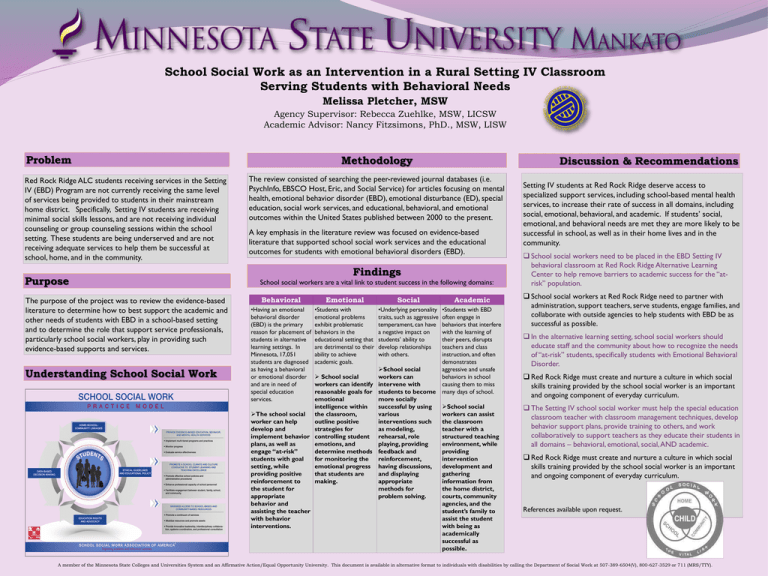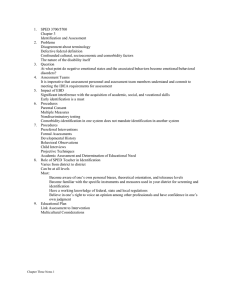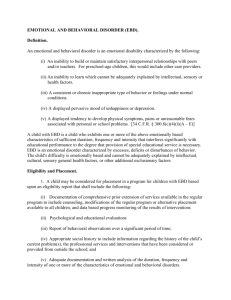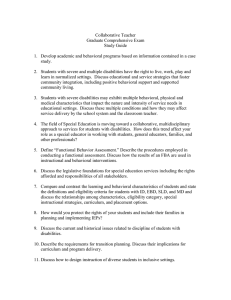School Social Work as an Intervention in a Rural Setting... Serving Students with Behavioral Needs
advertisement

School Social Work as an Intervention in a Rural Setting IV Classroom Serving Students with Behavioral Needs Melissa Pletcher, MSW Agency Supervisor: Rebecca Zuehlke, MSW, LICSW Academic Advisor: Nancy Fitzsimons, PhD., MSW, LISW Problem Red Rock Ridge ALC students receiving services in the Setting IV (EBD) Program are not currently receiving the same level of services being provided to students in their mainstream home district. Specifically, Setting IV students are receiving minimal social skills lessons, and are not receiving individual counseling or group counseling sessions within the school setting. These students are being underserved and are not receiving adequate services to help them be successful at school, home, and in the community. Purpose The purpose of the project was to review the evidence-based literature to determine how to best support the academic and other needs of students with EBD in a school-based setting and to determine the role that support service professionals, particularly school social workers, play in providing such evidence-based supports and services. Understanding School Social Work Methodology Discussion & Recommendations The review consisted of searching the peer-reviewed journal databases (i.e. PsychInfo, EBSCO Host, Eric, and Social Service) for articles focusing on mental health, emotional behavior disorder (EBD), emotional disturbance (ED), special education, social work services, and educational, behavioral, and emotional outcomes within the United States published between 2000 to the present. A key emphasis in the literature review was focused on evidence-based literature that supported school social work services and the educational outcomes for students with emotional behavioral disorders (EBD). Findings School social workers are a vital link to student success in the following domains: Behavioral Emotional Social •Having an emotional behavioral disorder (EBD) is the primary reason for placement of students in alternative learning settings. In Minnesota, 17,051 students are diagnosed as having a behavioral or emotional disorder and are in need of special education services. •Students with emotional problems exhibit problematic behaviors in the educational setting that are detrimental to their ability to achieve academic goals. •Underlying personality traits, such as aggressive temperament, can have a negative impact on students’ ability to develop relationships with others. Academic •Students with EBD often engage in behaviors that interfere with the learning of their peers, disrupts teachers and class instruction, and often demonstrates School social aggressive and unsafe School social workers can behaviors in school workers can identify intervene with causing them to miss reasonable goals for students to become many days of school. emotional more socially intelligence within successful by using School social The school social the classroom, various workers can assist worker can help outline positive interventions such the classroom develop and strategies for as modeling, teacher with a implement behavior controlling student rehearsal, role structured teaching plans, as well as emotions, and playing, providing environment, while engage “at-risk” determine methods feedback and providing students with goal for monitoring the reinforcement, intervention setting, while emotional progress having discussions, development and providing positive that students are and displaying gathering reinforcement to making. appropriate information from the student for methods for the home district, appropriate problem solving. courts, community behavior and agencies, and the assisting the teacher student’s family to with behavior assist the student interventions. with being as academically successful as possible. Setting IV students at Red Rock Ridge deserve access to specialized support services, including school-based mental health services, to increase their rate of success in all domains, including social, emotional, behavioral, and academic. If students’ social, emotional, and behavioral needs are met they are more likely to be successful in school, as well as in their home lives and in the community. School social workers need to be placed in the EBD Setting IV behavioral classroom at Red Rock Ridge Alternative Learning Center to help remove barriers to academic success for the “atrisk” population. School social workers at Red Rock Ridge need to partner with administration, support teachers, serve students, engage families, and collaborate with outside agencies to help students with EBD be as successful as possible. In the alternative learning setting, school social workers should educate staff and the community about how to recognize the needs of “at-risk” students, specifically students with Emotional Behavioral Disorder. Red Rock Ridge must create and nurture a culture in which social skills training provided by the school social worker is an important and ongoing component of everyday curriculum. The Setting IV school social worker must help the special education classroom teacher with classroom management techniques, develop behavior support plans, provide training to others, and work collaboratively to support teachers as they educate their students in all domains – behavioral, emotional, social, AND academic. Red Rock Ridge must create and nurture a culture in which social skills training provided by the school social worker is an important and ongoing component of everyday curriculum. References available upon request. A member of the Minnesota State Colleges and Universities System and an Affirmative Action/Equal Opportunity University. This document is available in alternative format to individuals with disabilities by calling the Department of Social Work at 507-389-6504(V), 800-627-3529 or 711 (MRS/TTY).





